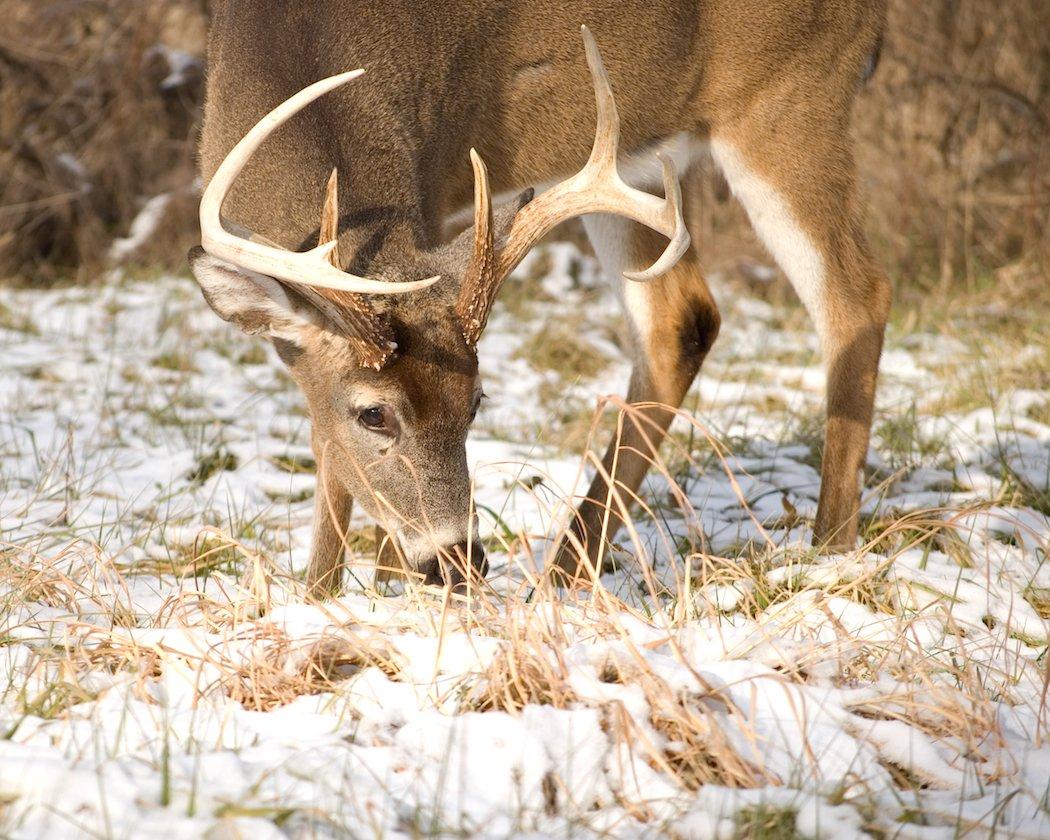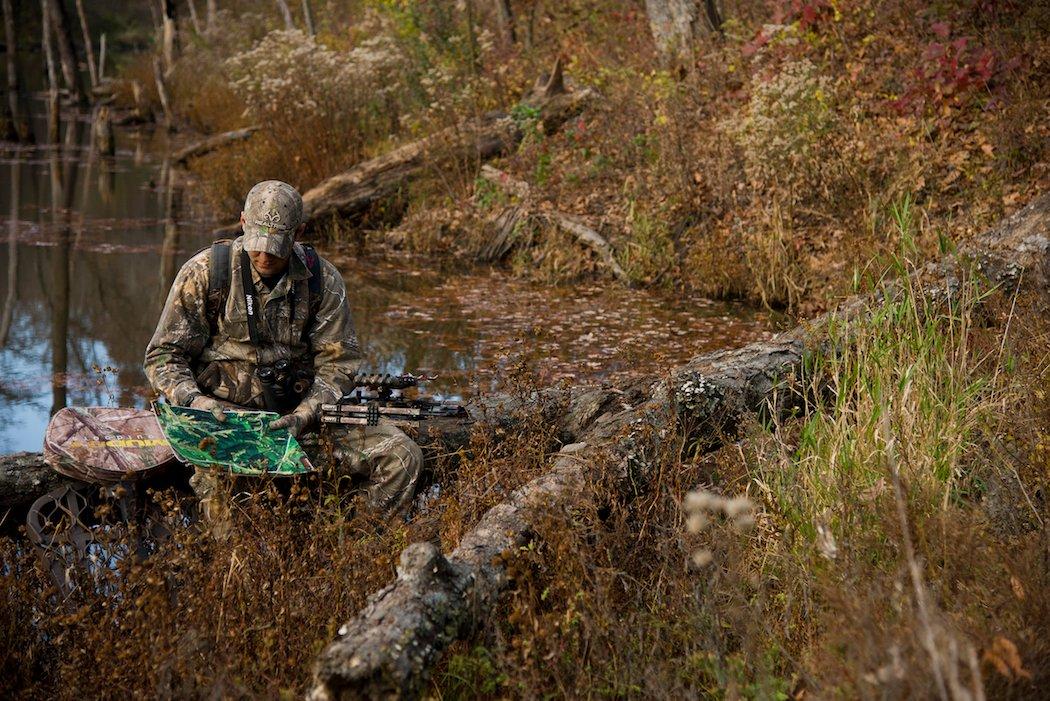How To Kill A Last-Minute Monster
The December sky cast a deep, gray shadow over the steep mountain country near my home. The temperature had been steadily declining since daylight, and the weather forecast was predicting a heavy snow to hit at any minute. I sat with my back against a wide-bodied oak tree overlooking a long wooded ridge that was flanked to the right by an old clear-cut. Over the years, a combination of prickly saw briars, underbrush and new sapling growth had transformed the clear-cut into a thick entangled mess. However, it was the perfect place for whitetails to escape several weeks of intense hunting pressure and the cold winter weather.
The hardwood ridge ran directly down the mountain into a creek bottom that was dotted with thickets, honeysuckle and overgrown fields that surrounded an abandoned farm house. This area was covered up with hot sign and the approaching snow storm was really starting to crank things up. Within a few minutes, a large flock of turkeys crossed within 20 yards of my stand, and I spotted several squirrels bouncing around the creek bottom. The cold front seemed to have everything on the move. All at once, the sky opened up and huge white flakes of snow began blanketing the ground. A quick surge of adrenaline shot through my entire body when two does eased out of the thicket and started down the ridge.
Next, a third deer cautiously stepped out of the snowy shadows and into a cleared shooting lane just below my setup. It was a heavy-racked mountain bruiser with super long tines and a kicker point shooting off its G3. One last deep breath and a gentle squeeze of my release trigger sent an arrow screaming toward the buck's vitals. A loud smack echoed across the mountain basin when the arrow collided with the top-heavy giant. The buck frantically ran down the ridge and crashed into a brush pile.
Without question, hitting the woods hard during the post-rut can pay off with a trophy of a lifetime. The following late-season strategies may enable you to punch one last tag and end your year with a monster buck.
RECOGNIZING PATTERN CHANGES
Understanding the daily habits of whitetails during the winter months is a key component of generating a productive hunt. Increasingly shorter days, colder weather, diminishing food sources and the terrain are all factors that directly dictate the overall behavior and daily habits of deer during the late season. Failure to recognize changes in deer patterns that occur during the post-rut can result in a lot of cold days in the stand without any action. Many deer hunters find that deer sign and the whitetails have mysteriously vanished during the late season. However, in most cases the deer are still in the same locations you are hunting, but seasonal changes in travel patterns and holding areas have been slightly modified.
During the late season, deer movement will primarily be governed by food. At this point, mature bucks are desperately trying to recover weight that was lost during the rut. In many cases, they will routinely try to bed near remaining food sources to conserve energy. If food resources are readily available, then deer will move to them even during periods of bone-chilling weather. On the other hand, if food is scarce, the deer may restrict their movements and stick tight to thick sheltered cover, especially during extreme winter weather. It's also not uncommon for older bucks to move more during the late morning to midday hours throughout the post-rut period. This is for good reason—it's warmer in the middle of the day.
FOCUS ON FOOD

Other important woodland food sources during the late season are honeysuckle, galax, several species of rhododendron, and mountain laurel. Whitetails will hit any of the remaining green groceries hard when acorns and other mast sources disappear. Thickets that encompass patches of honeysuckle, green briar and even the tender twigs from sapling tree branches can be key locations to hunt when the winter months roll around. Agricultural areas that offer late-season food sources like winter wheat, oats, clover and late-picked cornfields can also be excellent places to intercept hungry bucks. Without question, understanding a buck's stomach can help create a super close encounter with a bruiser that was smart enough to survive all the hunting pressure from earlier in the season. Locating late-season food sources should be your first move when trying to figure out exactly where to hang a productive late-season stand.
HUNT THE THICK STUFF
Trying to tag a wise old buck that has learned the ropes and knows how to trick most other hunters can be challenge during the late season. In some cases, it boils down to your ability to formulate a plan after working two important pieces of the post-rut puzzle. These two pieces involve finding a thick-cover sanctuary that is located within a short distance of a hot late-season food source. Heavy cover and long-tined giants go together like buttermilk biscuits and gravy. Over the years, bucks learn to utilize thickets to escape harsh winter weather and intense hunting pressure. Keep in mind that hard-to-reach late-season food sources along the edges of thick cover can hold some of the best post-rut hunting.
In many cases, agricultural food sources located close to roads or that offer easy hunting access will have been beaten to death by other hunters. Going the extra mile and focusing primarily on out-of-the way locations is the best bet. Bucks with reputations of being master escape artists will flock to these hideaways when the pressure is turned up and things get hectic. Carefully positioning a stand along the edge of bedding cover or above big buck travel routes leading to a late season food source can be deadly. This is exactly the strategy I used last season to tag a giant post-rut buck in the steep and rugged mountain country of southeastern Kentucky. It's a lot easier to establish a textbook feeding-to-bedding pattern during the late season because bucks simply don't have the food choices they enjoyed earlier in the year.
EXPLOIT OVERLOOKED HOTSPOTS

Right about now that one last deer tag has to be burning a hole in your pocket. There are several good reasons why you should hit the woods hard during the winter months. Minimal outside hunting pressure, limited food sources, increased midday activity and predictable patterns can give you the edge needed to bust a massive post-rut buck. The late season can be the perfect time to catch a big boy off guard and nail him when he least expects it. It's definitely one of my favorite transitional phases to hunt, and I've tagged some of my best bucks at this time. Give these post-rut tactics a try, but remember to have the number of your taxidermist on speed-dial. Now, get out there and make something happen!







